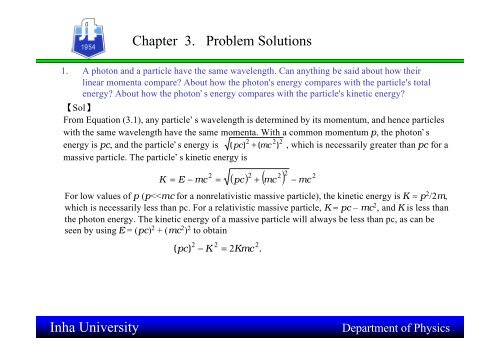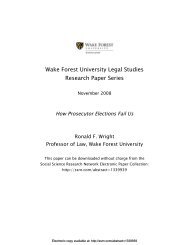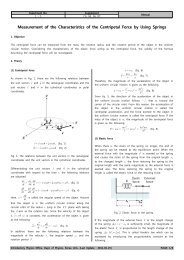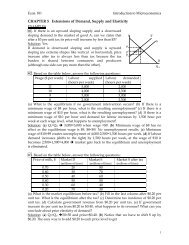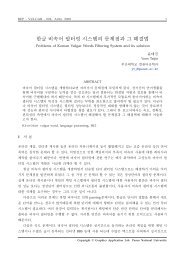Inha University Chapter 3. Problem Solutions
Inha University Chapter 3. Problem Solutions
Inha University Chapter 3. Problem Solutions
- No tags were found...
You also want an ePaper? Increase the reach of your titles
YUMPU automatically turns print PDFs into web optimized ePapers that Google loves.
<strong>Chapter</strong> <strong>3.</strong> <strong>Problem</strong> <strong>Solutions</strong>1. A photon and a particle have the same wavelength. Can anything be said about how theirlinear momenta compare? About how the photon's energy compares with the particle's totalenergy? About how the photon’s energy compares with the particle's kinetic energy?SolFrom Equation (<strong>3.</strong>1), any particle’s wavelength is determined by its momentum, and hence particleswith the same wavelength have the same momenta. With a common momentum p, the photon’s2 2 2energy is pc, and the particle’s energy is ( pc ) + ( mc ) , which is necessarily greater than pc for amassive particle. The particle’s kinetic energy isK2= E − mc=2 2 2( pc) + ( mc ) − mcFor low values of p (p
<strong>Chapter</strong> <strong>3.</strong> <strong>Problem</strong> <strong>Solutions</strong><strong>3.</strong> Find the de Broglie wavelength of a 1.0-mg grain of sand blown by the wind at a speed of 20 m/s.SolFor this nonrelativistic case,−34h 6.63 × 10 J ⋅ s−29λ = == <strong>3.</strong>3 × 10 m;mv−6( 1.0 × 10 kg)(20 m/s)quantum effects certainly would not be noticed for such an object.5. By what percentage will a nonrelativistle calculation of the de Broglie wavelength of a 100-keVelectron be in error?SolBecause the de Broglie wavelength depends only on the electron's momentum, the percentage errorin the wavelength will be the same as the percentage error in the reciprocal of the momentum, withthe nonrelativistic calculation giving the higher wavelength due to a lower calculated momentum.The nonrelativistic momentum isp nr=2mK== 1.71×10−22and the relativistic momentum is2(9.1×10kg ⋅ m/s,−31kg)(100 × 103eV)(1.6 × 10-19J/eV)p r=2 2 2 22−( K + mc ) − ( mc ) = ( 0.100 + ( 0.511)MeV / c = 1.79 × 10 kg ⋅ m/s,1 22c<strong>Inha</strong> <strong>University</strong>Department of Physics
<strong>Chapter</strong> <strong>3.</strong> <strong>Problem</strong> <strong>Solutions</strong>keeping extra figures in the intermediate calculations. The percentage error in the computed deBroglie wavelength is then( h / pnr) − ( h / pr) p − 1.79 − 1.71=r pnr== 4.8 %.h / p p 1.717. The atomic spacing in rock salt, NaCl, is 0.282 nm. Find the kinetic energy (in eV) of a neutronwith a de Broglie wavelength of 0.282 nm. Is a relativistic calculation needed? Such neutronscan be used to study crystal structure.SolA nonrelativistic calculation gives2r( hc / λ)22nrp( hc)( 1.24 × 10 eV ⋅ m)−3K = = = == 1.03×10 eV2m22 26-9 22mc2mcλ 2(939.6 × 10 eV)(0.282 × 10 m)(Note that in the above calculation, multiplication of numerator and denominator by c 2 and use ofthe product hc in terms of electronvolts avoided further unit conversion.) This energy is much lessthan the neutron's rest energy, and so the nonrelativistic calculation is completely valid.−62<strong>Inha</strong> <strong>University</strong>Department of Physics
<strong>Chapter</strong> <strong>3.</strong> <strong>Problem</strong> <strong>Solutions</strong>9. Green light has a wavelength of about 550 nm. Through what potential difference must anelectron be accelerated to have this wavelength?SolA nonrelativistic calculation gives222−62p ( hc / λ)( hc)( 1.24 × 10 eV ⋅ m)−6K = = = == 5.0 × 10 eV,2m22 23-9 22mc2(mc ) λ 2(511×10 eV)(550 × 10 m)so the electron would have to be accelerated through a potential difference of 5.0 x 10 -6 V = 5.0 µV.Note that the kinetic energy is very small compared to the electron rest energy, so the nonrelativisticcalculation is valid. (In the above calculation, multiplication of numerator and denominator by c 2 anduse of the product he in terms of electronvolts avoided further unit conversion.)11. Show that if the total energy of a moving particle greatly exceeds its rest energy, its de Brogliewavelength is nearly the same as the wavelength of a photon with the same total energy.SolIf E 2 = (pc) 2 + (mc 2 ) 2 >> (mc 2 ) 2 , then pc >> mc 2 and E ≈ pc. For a photon with the same energy,E = pc, so the momentum of such a particle would be nearly the same as a photon with the sameenergy, and so the de Broglie wavelengths would be the same.<strong>Inha</strong> <strong>University</strong>Department of Physics
<strong>Chapter</strong> <strong>3.</strong> <strong>Problem</strong> <strong>Solutions</strong>1<strong>3.</strong> An electron and a proton have the same velocity Compare the wavelengths and the phase andgroup velocities of their de Broglie waves.SolFor massive particles of the same speed, relativistic or nonrelativistic, the momentum will beproportional to the mass, and so the de Broglie wavelength will be inversely proportional to themass; the electron will have the longer wavelength by a factor of (m p /m e ) = 1838. From Equation(<strong>3.</strong>3) the particles have the same phase velocity and from Equation (<strong>3.</strong>16) they have the samegroup velocity.15. Verify the statement in the text that, if the phase velocity is the same for all wavelengths ofa certain wave phenomenon (that is, there is no dispersion), the group and phase velocitiesare the same.SolSuppose that the phase velocity is independent of wavelength, and hence independent of the wavenumber k; then, from Equation (<strong>3.</strong>3), the phase velocity v p = (ω/k) = u, a constant. It follows thatbecause ω = uk,dv g = ω = u = v p .dk<strong>Inha</strong> <strong>University</strong>Department of Physics
<strong>Chapter</strong> <strong>3.</strong> <strong>Problem</strong> <strong>Solutions</strong>17. The phase velocity of ocean waves is gλ/2π , where g is the acceleration of gravity. Findthe group velocity of ocean wavesSolThe phase velocity may be expressed in terms of the wave number k = 2π/λ asω g2v p = = , or ω = gk or ω = gk.k kFinding the group velocity by differentiating ω(k) with respect to k,dω1 1 1 g 1 ω 1vg = = g = = = v p .dk 2 k 2 k 2 k 2Using implicit differentiation in the formula for ω 2 (k),dω2ω = 2ωvg = g,dk2g gk ω ω 1so that vg = = = = = v p ,2ω2ωk2ωk2k2the same result. For those more comfortable with calculus, the dispersion relation may be expressed as2ln(ω)= ln( k ) + ln( g),dωdk1 ω 1from which 2 = , and vg= = v p.ω k2 k 2<strong>Inha</strong> <strong>University</strong>Department of Physics
<strong>Chapter</strong> <strong>3.</strong> <strong>Problem</strong> <strong>Solutions</strong>19. Find the phase and group velocities of the de Broglie waves of an electron whose kinetic energyis 500 keV.Sol21 K + mc 500 + 511For a kinetic energy of 500 keV, γ == = = 1.978.2 221 −v/ c mc 511Solving for v,22v = c 1 − ( 1/γ ) = c 1 − ( 1/1.978)= 0.863c,and from Equation (<strong>3.</strong>16), v g = v = 0.863c. The phase velocity is then v p = c 2 /v g = 1.16 c.21. (a) Show that the phase velocity of the de Broglie waves of a particle of mass m and de Brogliewavelength λ is given by21⎛mcλv⎞p = c + ⎜ ⎟⎝ h ⎠(b) Compare the phase and group velocities of an electron whose de Broglie wavelength isexactly 1 x 10 -13 m.Sol(a)Two equivalent methods will be presented here. Both will assume the validity of Equation(<strong>3.</strong>16), in that v g = v.First: Express the wavelength x in terms of v g ,<strong>Inha</strong> <strong>University</strong>hλ =ph=mv γg=hmvgv1 −c2g2.Department of Physics
Multiplying by mv g , squaring and solving for v g 2 gives222 h⎡2 ⎛mλc⎞ ⎤v g == c 1 .2 2 2⎢ + ⎜ ⎟ ⎥( λm)+ ( h / c ) ⎢⎣⎝ h ⎠ ⎥⎦Taking the square root and using Equation (<strong>3.</strong>3), v p = c 2 /v g , gives the desired result.Second: Consider the particle energy in terms of v p = c 2 lv g ;E<strong>Inha</strong> <strong>University</strong>22= ( pc)2+2( mc )22−1222 2( ) ( mc ) ⎛hc⎞ 2 2mc == ⎜ ⎟ + ( mc ) .γ2 21 − c / v p ⎝ λ ⎠Dividing by (mc 2 ) 2 leads to2c 11 −so that2=,2 2v p 1 + h /( mcλ)22 2c1 h ( mcλ)1− 1 ===22 2 2 2v 1+h /( mcλ ) h ( mcλ)+ 1 1 + ( mcλ)pwhich is an equivalent statement of the desired result.It should be noted that in the first method presented above could be used to find λ in terms of v pdirectly, and in the second method the energy could be found in terms of v g . The final result is, orcourse, the same.2/ h2,Department of Physics
<strong>Chapter</strong> <strong>3.</strong> <strong>Problem</strong> <strong>Solutions</strong>25. In Sec. <strong>3.</strong>5 it was mentioned that the energy of an electron entering a crystal increase, whichreduces its de Broglie wavelength. Consider a beam of 54-eV electrons directed at a nickeltarget. The potential energy of an electron that enters the target changes by 26 eV. (a) Comparethe electron speeds outside and inside the target. (b) Compare the respective de Brogliewavelengths.Sol(a) For the given energies, a nonrelativistic calculation is sufficient;v=2Km=2(54 eV)(1.60 × 10−31-19J/eV)= 4.36 m/s9.1×10 kgoutside the crystal, and (from a similar calculation, with K = 80 eV), v = 5.30 x 10 6 m/s inside thecrystal (keeping an extra significant figure in both calculations).(b) With the speeds found in part (a), the de Brogile wavelengths are found from−346 −10h h . 63 × 10 J ⋅ sλ = = == 1.67 × 10p mv−316( 9.11×10 kg)(4.36 × 10 m/s)or 0.167 nm outside the crystal, with a similar calculation giving 0.137 nm inside the crystal.m,<strong>Inha</strong> <strong>University</strong>Department of Physics
<strong>Chapter</strong> <strong>3.</strong> <strong>Problem</strong> <strong>Solutions</strong>27. Obtain an expression for the energy levels (in MeV) of a neutron confined to a one-dimensionalbox 1.00 x 10 -14 m wide. What is the neutron's minimum energy? (The diameter of an atomicnucleus is of this order of magnitude.)SolFrom Equation (<strong>3.</strong>18),22 h 2 ( 6.63 × 10 J ⋅ s)2−13E n = n = n= n <strong>3.</strong>28 × 10 J = n2−27-14 28mL8(1.67 × 10 kg)(1.00 × 10 m)The minimum energy, corresponding to n = 1, is 20.5 MeV−3429. A proton in a one-dimensional box has an energy of 400 keV in its first excited state. Howwide is the box?SolThe first excited state corresponds to n = 2 in Equation (<strong>3.</strong>18). Solving for the width L,2220.5 MeV.L =n2h8mE2=28(1.67 × 10−27( 6.63×10−34kg)(400 × 103J ⋅ s)2eV)(1.60 × 10-19J/eV)=4.53×10−14m=45.3 fm.<strong>Inha</strong> <strong>University</strong>Department of Physics
<strong>Chapter</strong> <strong>3.</strong> <strong>Problem</strong> <strong>Solutions</strong>31. The atoms in a solid possess a certain minimum zero-point energy even at 0 K, while no suchrestriction holds for the molecules in an ideal gas. Use the uncertainty principle to explain thesestatements.SolEach atom in a solid is limited to a certain definite region of space - otherwise the assembly of atomswould not be a solid. The uncertainty in position of each atom is therefore finite, and its momentumand hence energy cannot be zero. The position of an ideal-gas molecule is not restricted, so theuncertainty in its position is effectively infinite and its momentum and hence energy can be zero.3<strong>3.</strong> The position and momentum of a 1.00-keV electron are simultaneously determined. If itsposition is located to within 0.100 nm, what is the percentage of uncertainty in its momentum?SolThe percentage uncertainty in the electron's momentum will be at least∆ph hhc= ==p 4πp∆x4π∆x2mK24π∆x2(mc)K=4π(1.00 × 10−10( 1.24 × 10m)−62(511×10eV ⋅ m)3eV)(1.00 × 103eV)= <strong>3.</strong>1×10−2= <strong>3.</strong>1 %.Note that in the above calculation, conversion of the mass of the electron into its energy equivalent inelectronvolts is purely optional; converting the kinetic energy into joules and using h = 6.626 x 10 -34J·s will of course give the same percentage uncertainty.<strong>Inha</strong> <strong>University</strong>Department of Physics
<strong>Inha</strong> <strong>University</strong><strong>Chapter</strong> <strong>3.</strong> <strong>Problem</strong> <strong>Solutions</strong>35. How accurately can the position of a proton with v
37. A marine radar operating at a frequency of 9400 MHz emits groups of electromagnetic waves0.0800 µs in duration. The time needed for the reflections of these groups to return indicatesthe distance to a target. (a) Find the length of each group and the number of waves it contains.(b) What is the approximate minimum bandwidth (that is, spread of frequencies) the radarreceiver must be able to process?Sol(a) The length of each group isc∆ t = ( <strong>3.</strong>0 × 108m/s)(8.0×10-5s) = 24 m.The number of waves in each group is the pulse duration divided by the wave period, which is thepulse duration multiplied by the frequency,86( 8.0 × 10− s)(4900×10 Hz) = 752 waves.(b) The bandwidth is the reciprocal of the pulse duration,−8-1( 8. 0 × 10 s) = 12.5 MHz.<strong>Inha</strong> <strong>University</strong>Department of Physics
<strong>Inha</strong> <strong>University</strong><strong>Chapter</strong> <strong>3.</strong> <strong>Problem</strong> <strong>Solutions</strong>39. The frequency of oscillation of a harmonic oscillator of mass m and spring constant C isν = C / m / 2π.The energy of the oscillator is E = p 2 /2m + Cx 2 /2, where p is itsmomentum when its displacement from the equilibrium position is x. In classical physicsthe minimum energy of the oscillator is E min = 0. Use the uncertainty principle to find anexpression for E in terms of x only and show that the minimum energy is actually E min =hν/2 by setting dE/dx = 0 and solving for E min .SolTo use the uncertainty principle, make the identification of p with ∆p and x with ∆x, so thatp = h/ (4πx), and⎛ 2h ⎞ 1 ⎛C⎞ 2E = E(x)= ⎜ ⎟+ x .2 2⎜ ⎟8 m⎝ π ⎠ x ⎝ 2 ⎠dDifferentiating with respect to x and setting E = 0,dx⎛ 2 ⎞⎜h 1− ⎟+ = 0,2 34Cx⎝ π m ⎠ xwhich is solved forhx2 = .2π mCSubstution of this value into E(x) gives⎛ 2h ⎞⎛2πmC ⎞ ⎛C⎞⎛h ⎞ h C hνE min = ⎜ ⎟.8π2 ⎜ ⎟ = =m⎜⎟h⎟+ ⎜⎝ ⎠⎝⎠ ⎝ 2 ⎠⎝2πmC ⎠ 2πm 2Department of Physics


